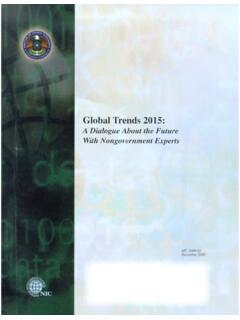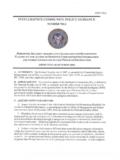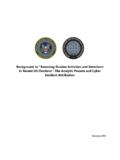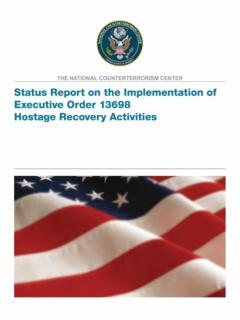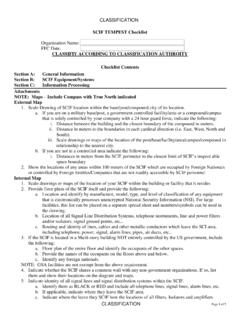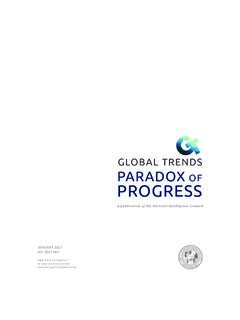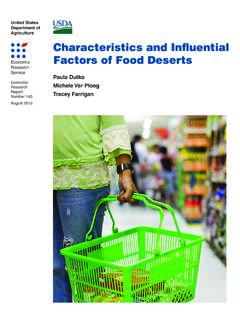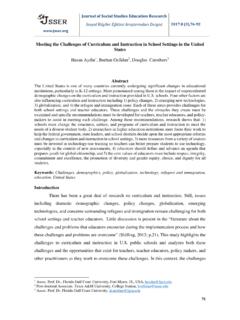Transcription of Natural Resources in 2020, 2030, and 2040: Implications ...
1 This paper does not represent US Government views. This paper does not represent US Government views. NATIONAL INTELLIGENCE COUNCIL REPORT NICR 2013-05, 25 July 2013 This is not an IC-coordinated report. This paper does not represent US Government views. Natural Resources in 2020, 2030, and 2040: Implications for the united states This paper does not represent US Government views. This paper does not represent US Government views. This report was prepared by Chatham House under the auspices of the Director, Strategic Futures Group.
2 It was reviewed by the National Intelligence Council and other members of the Intelligence Community (IC), but was not formally coordinated. This paper does not represent US Government views. i This paper does not represent US Government views. Scope Note US National Security Impacts of Natural Resources in 2020, 2030, and 2040 This is not an IC-coordinated report. The cut-off date for information used in the report was July 2012. Based on the general contention that the world is entering an intensified period of resource stress, the National Intelligence Council (NIC) asked Chatham House in July 2011 to conduct research to identify the most important Natural resource trends affecting US national security over a 2020, 2030, and 2040 time horizon.
3 The requested analysis covers water, fuel, food, and metals (also referred to as materials). The identified trends which include patterns of demand, supply, availability, price levels, and price volatility are shaped and influenced by emerging climate changes, evolving demographic patterns, increasing economic development, and human induced environmental degradation. The result is this report which considers how local and global availability of Natural Resources will affect US security interests in the medium term (to 2020) and long term (specifically 2030 and 2040).
4 The 2020 date was selected to identify the most pressing policy relevant issues; 2030 was selected to support development of the NIC s longer-range Global Trends series; and 2040 to support ongoing NIC projects exploring the national security impact of global food, water, and energy security. The major assumption underpinning this analysis is that mounting prosperity in both the developed and the developing world will continue to drive increased consumer demand for key Resources . At the same time, constraints in energy, water, and other critical Natural Resources and infrastructure, together with socio- economic shifts, will bring new and hard-to-manage instabilities.
5 There will be an increasing risk of discontinuous and systemic shocks to 2040 as a consequence of these factors. This report identifies potential Natural resource stresses (in terms of aggregate availability, absolute prices, or rapid price changes) and analyzes their likely impact on the united states and states /regions of interest to the united states . The report also explores how these stresses will interact with one another and other pre-existing conditions, including poverty, social tensions, environmental degradation, ineffectual leadership, and weak political institutions.
6 Summary tables (Annex A) provide an overview of key resource-related threats and their potential impact on the united states and other major economies. The risk assessments are based on a continuation of today's practices and trends; alternate policy choices, market actions, and technology developments will likely change future risk assessments. Annex B provides fuller description of the tasking given to Chatham House and the results it produced. Resource trends including future consumption, production, prices, and availability are subject to large uncertainties and for many types of Resources detailed forecasts are not available (Annex C).
7 This paper does not represent US Government views. ii This paper does not represent US Government views. Threats to states of Interest to the united states Generic Threats states of Interest Type of Threat Trigger Event(s) Timeframe Underlying Pressures Risk of Occurrence High and Volatile International Food Prices Import-dependent countries with poor, urbanized populations: Mexico, Pakistan, Azerbaijan, Syria, Iraq, Egypt, Democratic Republic of the Congo, Philippines, North Korea Producing countries that may impose export restrictions in response to high prices.
8 Argentina, Brazil, Russia, Ukraine, Thailand, Indonesia Riots and political instability Regime collapse High inflation Further destabilization of global food markets Panic buying by consumer countries Natural disasters or water shortages in producer countries (2020, 2030, 2040). Export restrictions by producer states (2020) Oil price spikes (2020, 2030) Rise in consumption in emerging economies Water shortages Climate volatility Oil price volatility Population growth High High and Volatile International Energy Prices Developing countries with high import-dependence.
9 Eastern European countries, Caribbean Islands, Chile, India, Turkey Riots and political instability Regime collapse Deteriorating public finances as subsidies expand High inflation and economic crises Conflicts or social disruptions in energy producing regions (2030, 2040) Terrorist attacks on critical energy infrastructure (2020, 2030, 2040) Water shortages in producer countries (2020, 2030, 2040) Critical infrastructure damage from extreme weather events (2030, 2040) Weak governance of resource producers Climate volatility Rise in consumption in emerging economies Water shortages High (Continued on page ) This paper does not represent US Government views.
10 Iii This paper does not represent US Government views. Resources in 2020, 2030, and 2040: Implications for the united states Executive Summary The Bottom Line: At the aggregate level, there are significant scarcity challenges for a number of key Natural Resources with potential impact on US security. Markets for agricultural commodities will remain tight through to 2020 and probably to 2030, with maize experiencing the largest increase in prices. Significant wheat production occurs in water-stressed and climate vulnerable regions in Asia (China, India, Pakistan, and Australia); markets therefore will remain susceptible to harvest shocks.

